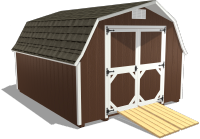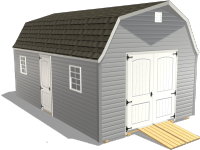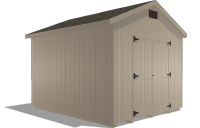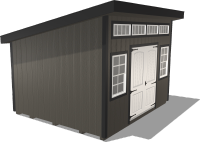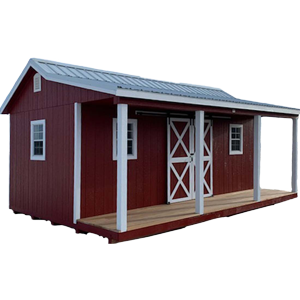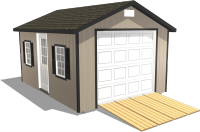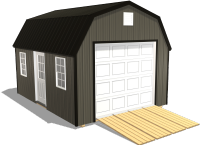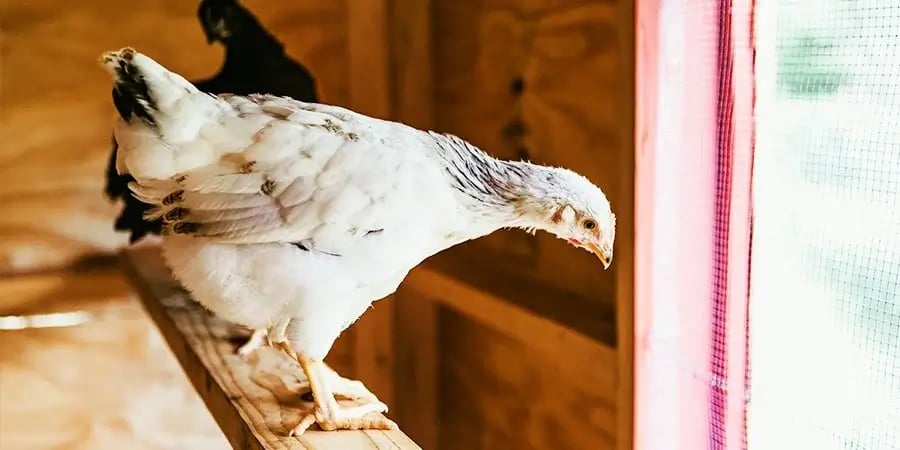How To Raise Chickens in Winter
by Dakota Storage Buildings, on December 08, 2021
There’s a lot you can do to keep your chickens warm and comfortable in the winter.
If you’re new to raising chickens and wonder how to take care of them in the winter, like: Where do people keep their chickens in the winter? What temperature is too cold for chickens? Do chickens need a coop in winter? Can chickens survive winter without heat?
While you may be worried that your chickens will be cold during the winter, you can do a lot to make them comfortable. Here are some tips that will keep your hens happy and healthy in the coldest months, including how to keep them warm, ways to keep their coop dry and draft-free, and what to feed them.
Where to Keep Chickens in the Winter
Chickens can live outdoors all year round as long as they have access to a draft-free coop. If it's cold outside, they can head into the coop. They're hardier than you might think and aren't as averse to cold as people often assume. Despite the cold temperatures, chickens regulate their body temperatures with the help of their undercoat of feathers and increased food intake.
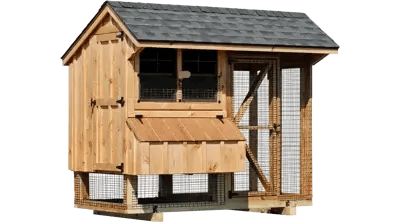
Need a chicken coop?
Explore our free-range and enclosed options.
How to Keep Chickens Warm in the Winter
What temperature is too cold for chickens? Cold weather chickens can withstand temperatures slightly below freezing, but almost all breeds can tolerate cold winter temperatures when the following measures are implemented.
Draft-Free Chicken Coop
While their feathers are natural insulation and can keep them warm in freezing temps, it's crucial to have a draft-free coop. While some air needs to be exchanged to prevent moisture accumulation and ammonia build-up, limit it to a roof vent or high window, just enough for fresh air to enter and stale air to exit.
Extra Bedding
Adding extra bedding to the coop in the wintertime is a great way to help insulate it and give hens a place to burrow and stay cozy. A nice thick layer of straw on the floor (12″ or more) will provide insulation against the chill from the ground. Straw is one of the best insulators since warm air is trapped in the hollow shafts.
Alternatively, if you have time before winter, the deep litter method is an ideal solution to managing coop bedding and warmth in the winter. The deep litter method is when bedding material and chicken excrements build up in the coop over the spring, summer, and fall so that by winter, you have roughly a foot of composting material on the floor of the coop. This compost and bedding mixture will give off heat, warming the coop naturally. The key is to keep turning it over so it can dry out and deteriorate. It's important to note that this method can pose a health hazard to your chickens if proper ventilation and moisture balance are not maintained.
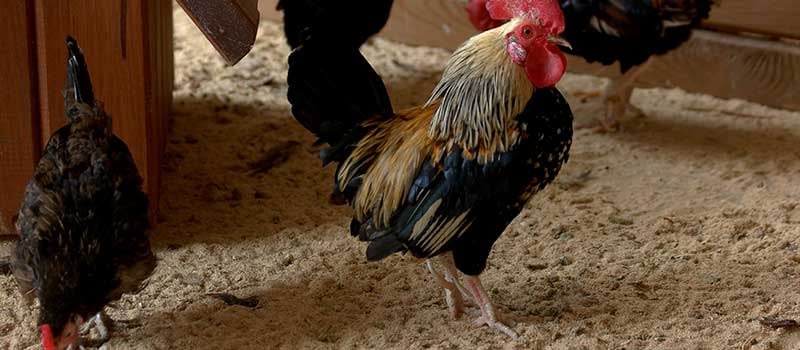
Regardless of your bedding choice, be sure to remove wet spots daily during winter months to prevent mold, fungus, and bacteria growth which can cause health problems for your chickens.
While it might sound like a good idea, don't put a heater in your backyard chicken coop for winter warmth. Bedding is sufficient. Aside from being a potential fire hazard, they create an extreme temperature change. When a chicken enters a heated coop from the cold outdoors, it shocks their system. Drastic temperature changes are rough for chickens and can cause death.
Roost
Make sure you have plenty of space for all your chickens to roost comfortably. If a hen is on the ground, there's not enough space. Chickens will roost together and fluff themselves out to keep warm. Roosts, which should be raised at least 2-3 feet from the coop floor, keep chickens off the cold ground.
What to Feed Chickens in the Winter
During the winter, chickens need more energy to maintain internal warmth. To make energy, they need carbs and protein more often throughout the winter. While protein and carbs increase energy, carbs convert into energy faster than protein, which is why scratch and corn are popular morning and evening snacks. However, if you feed either to your chickens, make sure it doesn't comprise more than 10% of their total diet.
Chickens need to have access to water all day, all year round, but that can be tough in the winter when temperatures drop below freezing. Check their water supply at least twice a day to make sure their water hasn’t frozen. Since watering should be done outside (not in the coop), make sure the waterer is in a location that's exposed to the sun. If it continues to freeze, try using a wide/deep black rubber tub or move to a heating pan, an immersion heater, or even an electric dog water bowl.
What Egg-Laying Looks Like in the Winter
Hens need 14-16 hours of light to produce eggs. As daylight decreases in the winter, chickens naturally lay fewer eggs or stop laying altogether. This shift in seasons gives hens a break and a chance to recharge.
While some chicken breeds are great layers through the winter, most require artificial light to supplement daylight through the winter if year-round egg-laying is the goal. However, artificial light throws off a chicken's cycle, which can cause stress and a shortened laying life. Also, temperatures below freezing result in frozen eggs. As eggs freeze, the contents expand, causing eggs to crack before they're collected.
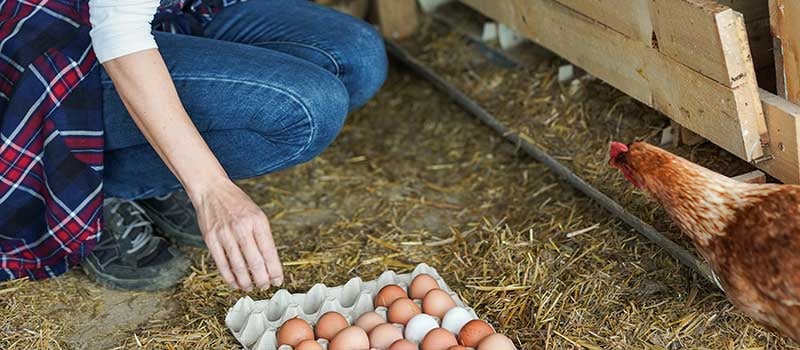
What to do With Bored Chickens in the Winter
Chickens can get bored during the winter, so it’s critical to find ways to keep them active. For instance, tie up a head of cabbage in the coop so they can peck at it while it bobs or fill a couple of empty plastic bottles with corn and poke a few holes in it so the corn can fall out as they move it around.
If you're worried about your hens not leaving the coop, you can cover their run with a tarp when it's raining or snowing, keeping the ground dry. Or, if you don't have an enclosed run, you can create a DIY sunroom or greenhouse-style addition, allowing them to get sunlight while keeping a portion of the space protected from the elements. Both of these options will encourage chickens to wander out of the coop, allowing them to stretch their legs and get fresh air. Also, consider adding outside roosts, ladders, perches, piles of leaves, straw, hay, or a dust bath station.
How to Prevent Frostbite
In the coldest winter climates, breeds with large combs and wattles can get frostbite. Frostbite is caused by excess moisture in the cold air, which freezes the fluid in the cells of a chicken's wattles, comb, or toes. The most important frostbite prevention measures are to reduce moisture by removing damp coop bedding, improving coop ventilation, and eliminating drafts. You can also cover combs and wattles with petroleum jelly. However, if your chickens do get frostbite, it is usually nothing serious as just the tips of the combs are affected.
Conclusion
It's low risk to raise chickens in the winter if you take the precautions outlined in this article. The chances of your chickens surviving the winter are high, so there's nothing to be overly concerned about so long as they have a quality coop with a lot of dry bedding and plenty to eat. They'll take care of the rest themselves.
If you don't have chickens yet but are thinking about getting some in the spring, there are some important things to know before diving in headfirst. Download our guide to learn more about raising chickens.
More reading:
- The Beginners Guide to Getting Backyard Chickens
- Different Types of Chicken Breeds for Backyard Chicken Owners
- What to Know Before Buying and Raising Backyard Chickens
- Should You Buy or DIY a Backyard Chicken Coop?
- Finding the Best-fit Chicken Coop for Your Flock
- Dakota Storage Building Chicken Coops
- More chicken and coop articles





